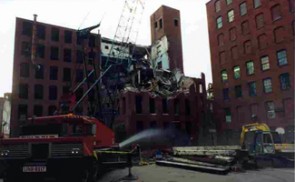Blast & Vibration Monitoring
Whether your firm is driving piles to provide support for the installation of bridges or other structures, or blasting to remove a bedrock outcrop for a roadway, you must be concerned about the effects of vibration on nearby buildings and other structures. Before your project starts, you need to know the potential for damage so you can plan your work in a manner that will avoid causing damages. During and after the project, it is imperative to have data concerning vibration levels in case of litigation by property owners or occupants. Pre-blast surveys and vibration monitoring provides this information for you.
Why Hager Richter?
Hager-Richter has conducted pre-blast and post-blast inspections, on-site blast & vibration monitoring, and investigations of claims of damage due to blasting. Our web-enabled vibration monitoring seismographs offer the latest technology in cost-effective vibration monitoring services. Hager-Richter’s experience ensures that you, the client, can depend on the accuracy of our data. Examples of our projects are:
- Determination of cause of fly rock accident and recommendation of remedial action to prevent future problems
- Examination of alleged cause of collapse of structure from blasting
- Pre-blast inspection and documentation of over 100 residential and commercial structures prior to opening of crushed stone quarry
- Examination of alleged damage due to blasting and determinations of probable cause in Massachusetts, Maine, New Hampshire, Pennsylvania, New York, and New Jersey
- Vibration monitoring to document seismic vibration levels in the following projects:
- Construction of access ramps to shopping mall
- Installation of sewer lines near historic structures
- Construction of a bridge
- Replacement of an historic bridge
- Construction of hospital and medical buildings
- Construction of an access road for condominiums
- Expansion of an electronics facility and landscaping
- Quarry blasting
- Demolition of large industrial buildings
- Pile driving activities

